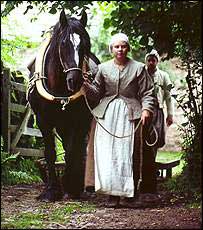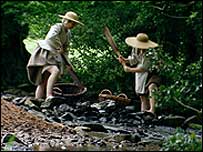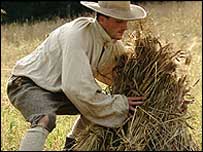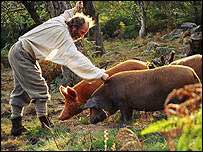livingontheland@lists.ibiblio.org
Subject: Healthy soil and sustainable growing
List archive
[Livingontheland] Lessons from our ancestors about the countryside
- From: "Kathy" <Vanokat@mrtc.com>
- To: <TheFrontPage@yahoogroups.com>
- Subject: [Livingontheland] Lessons from our ancestors about the countryside
- Date: Thu, 8 Nov 2007 16:35:58 -0500
|
Published on Tuesday, July 10, 2007 by BBC News Magazine Lessons from our ancestors about the countryside
By Megan Lane
The BBC series Tales from the Green Valley follows historians and archaeologists as they recreate farm life from the age of the Stuarts. They wear the clothes, eat the food and use the tools, skills and technology of the 1620s. It was a time when daily life was a hard grind, intimately connected with the physical environment where routines were dictated by the weather and the seasons. A far cry from today's experience of the countryside, which for many involves a bracing walk ahead of a pub lunch. While few would choose to live a 17th Century lifestyle, the participants found they picked up some valuable tips for modern life. 1. Know thy neighbours. Today it's possible to live alone, without knowing anyone within a 20-mile radius (the same goes for townies). That was simply not possible in the past - not only did the neighbours provide social contact, people shared labour, specialist skills and produce. "And women were judged on good neighbourliness," says historian Ruth Goodman. "If you were willing to help others - particularly during and after childbirth - then others would be more prepared to help you in times of need." 2. Share the load. It was nigh on impossible to run a 1620s farm single-handedly, and the family - either blood relatives, or a farmer, his wife and hired help - had to be multi-skilled. Labour, too, was often divided along gender lines, but at busy periods, such as harvest time, it was all hands on deck.
4. Eat seasonally. Today it's because of "food miles" and the inferior quality of forced products. In the 1620s, it was because foods were only available at certain times of year - and not just fruit and veg. Mutton, for instance, was in abundance in spring, soon after shearing time. This was because a sheep's wool quality plunges after eight years - thus animals of that age were killed after their final fleece was removed. 5. Tasty food comes in small batches. Today farmers' markets are a tourist attraction and many delight in regional specialities. For these producers play to the strengths of their ingredients, unlike, for instance, the makers of mass-produced cheese. This has to taste the same year-round, despite seasonal variations in milk quality. "So high-quality milk in the spring is downgraded so the finished product is consistent throughout the year," says Ms Goodman. 6. Reuse and recycle. Today we throw away vast mountains of packaging, food, garden waste and other materials. In 1620s, there was a use for everything, with tattered bed linens made into fire-lighters and animal fat into soap. Even human waste had uses. Faeces was a fertiliser, and urine was stored to make ammonia to remove laundry stains.
8. Corsets, not bras. "By that I don't mean Victorian corseting," says Ms Goodman. "Corsets support your back as well as your chest, and don't leave red welts on your skin like bra elastic does. They made it hard to breath walking up hills, but I get short of breath doing that anyway. And most people feel sexy in a corset."
9. Reliance on any one thing leaves you vulnerable. Hence the country ground to a halt during the petrol blockades of 2000, and a shortage of coal during 1978-9's Winter of Discontent caused electricity shortages. On the 1620s farm, when oxen used to plough fields fell ill, the implements were reshaped and horses did the job instead. 10. No pesticides means a richer variety of birds, butterflies and other insects, many of which feast on pests - a result as desirable for the gardener as the farmer. And the hedgerow and fields of wild flowers of the past are today making a comeback, as these provide habitats for these creatures and allow edible plants to flourish. |
- [Livingontheland] Lessons from our ancestors about the countryside, Kathy, 11/08/2007
Archive powered by MHonArc 2.6.24.



